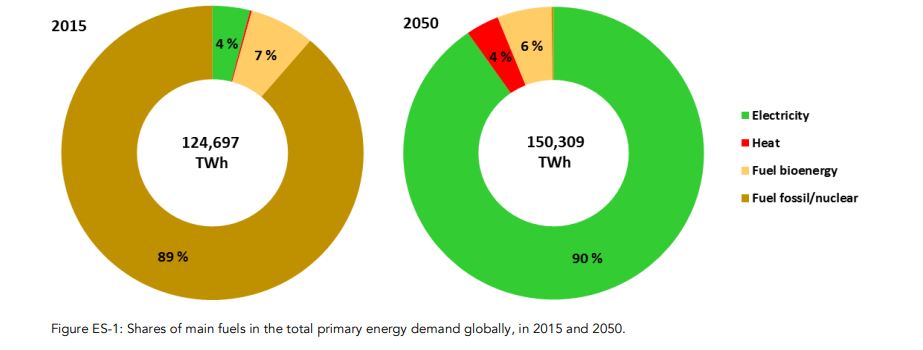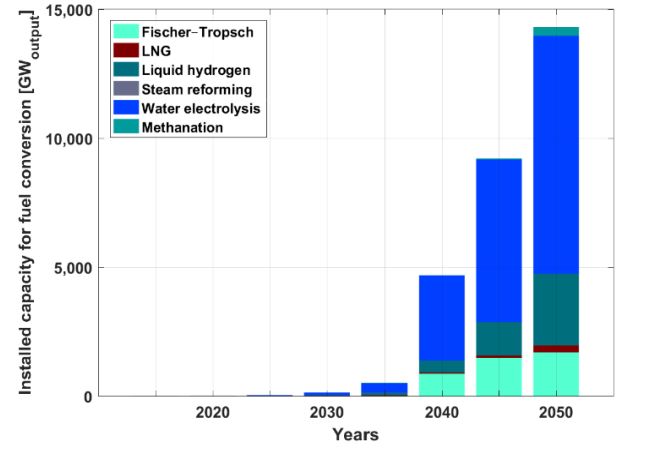Can We Do Without Natural Gas? [Gas Transitions]
Researchers from LUT University have been co-operating with the Energy Watch Group (EWG), a global network of scientists and parliamentarians whose goal it is to support climate policy with objective information, for a number of years. Their latest combined study was published on 12 April 2019. It purports to show that “a global transition to 100% renewable energy across all sectors before 2050 is feasible, secure and more cost effective than the current fossil fuel and nuclear-based energy system,” as the press release puts it. The study is dedicated to “Greta Thunberg and the whole #FridaysForFuture movement.”
The LUT-EWG study envisages two key steps in getting to 100% renewables: first, massive electrification, second, massive expansion of solar and wind power.
According to the report, solar power will account for 69% of power/energy supply by 2050, wind energy will deliver 18%, and the remaining 13% will be supplied mostly by bioenergy (6%) and hydro (3%).
This is how LUT-EWG sees the energy system change:
Note that the LUT-EWG study assumes modest energy demand growth of 1.8%/year on average (not cumulative). The researchers assume that world population will grow from 7.2bn to 9.7bn by 2050 and that average per capita primary energy demand will decrease from around 17 MWh/person in 2015 to 12 MWh/person by 2035 and then increase again to 15 MWh/person by 2050.
Incidentally, the primary energy demand assumed for 2015 (124,697 TWh) seems very low. Both the IEA World Energy Outlook and the BP Energy Outlook estimate global energy demand in 2015 at around 13,500 MToe, which is equivalent to 156,600 TWh.
This is how the energy mix would change according to the LUT-EWG study:
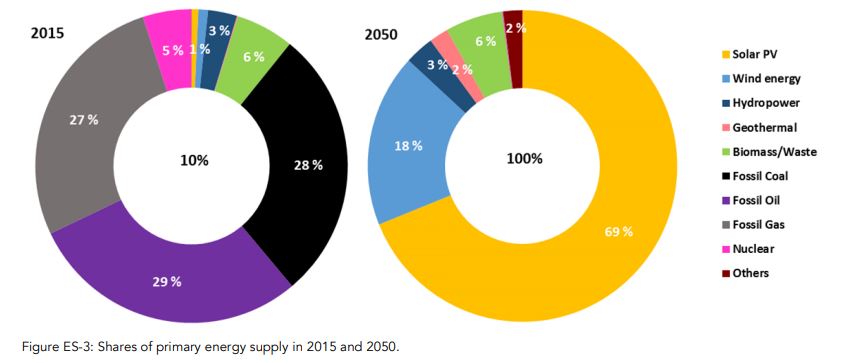
The key point to note here is that reaching these levels of renewable energy will require a total installed capacity of some 63,400 GW of solar PV and 8,000 GW of wind energy, according to the report. That is rather a tall order if you consider that the world had installed 512 GW of solar power and 600 GW of wind power at the end of 2018.
To get from 512 GW solar power to 63,4000 GW solar PV would require installing over 2000 GW/year for 30 years. In 2017 some 95 GW of new solar power capacity was installed and in 2018, a little over 100 GW, according to press reports. This means that the current rate of new solar installations will have to increase 20-fold to realise the LUT-EWG future. For wind power the numbers seem more doable: 240 GW/year for 30 years is four or five times the current installation rate.
It won’t come as a surprise that in the LUT-EWG scenario, energy storage plays a critical role. The renewable power sources will have to be balanced out after all. According to the study, energy storage would cover about 23% of electricity demand and about 26% of heat demand in 2050.
The production of synthetic fuels would also play a critical role, especially the production of hydrogen through electrolysis:
Another statistic that may be interesting is how, according to the LUT-EWG researchers, heat supply would be transformed:
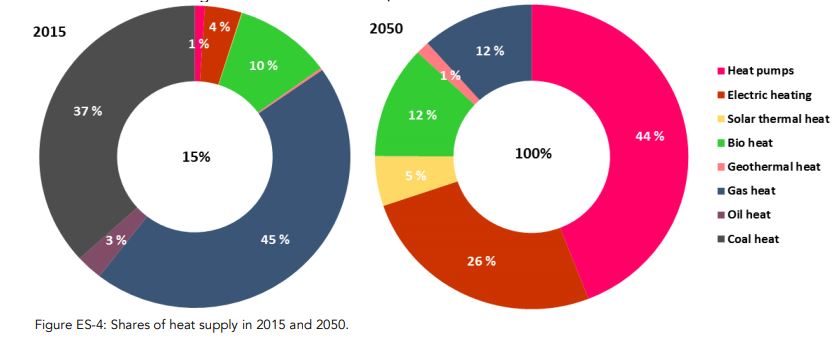
Europe: batteries needed
To bring the LUT-EWG numbers a bit closer to home (for me), I looked specifically at Europe. The report envisages an expansion of European power production capacity from 1,200 GW to 11,400 GW, of which 8,940 GW will be solar power and around 2,260 GW wind power (1,800 onshore and 460 GW offshore).
Again, these are very tall orders, particularly the one for solar power.
The EU had some 106 GW of solar PV capacity installed at the end of 2017. In 2018, it installed another 8 GW (for the whole of Europe the number was 11 GW). To get to 8,940 GW, however, Europe would need to install some 293 GW per year over 30 years, that’s 26 times the current rate of new installations!
For wind power the figures are a bit better, but not much. Currently, European wind power capacity is 189 GW. To get to 2260 GW requires 69 GW of new wind power capacity installed each year over 30 years. In 2018, 11.7 GW of new wind power capacity was installed, so the installation rate would have to grow 6-fold. This applies both to offshore and onshore wind power. (Offshore wind capacity currently stands at 19 GW. To get to 460 GW, some 14.7 GW of new offshore wind capacity has to be installed every year. Last year, 2.65 GW of offshore wind was installed in Europe.)
That’s not all, because the LUT-EWG study also projects a huge expansion of battery storage capacity. It notes that for Europe “batteries emerge as the most relevant electricity storage technology contributing about 83% of the total electricity storage output by 2050.”
According to the study, “electricity demand covered by energy storage” will be about 3,000 TWh in 2050, of which some 2,300 TWh will be delivered by electricity storage (see figure below):

If 83% of this is to be delivered by batteries, these would have to supply around 1900 TWh of electricity in 2050.
To get a sense of how much this is, note that according to Bloomberg New Energy Finance (BNEF), an organisation that is not bearish on batteries, global battery capacity will reach 2,857 GWh by 2040. That is gigawatt-hours, and for the whole world. The LUT-EWG study is talking about terawatt-hours, just for Europe.
I asked the Energy Watch Group about this and received an extensive answer which I have reproduced in full: see footnote below.
Irena scenario
Given the very high numbers projected for solar and wind power as well as for storage needed to back up the intermittent renewables, I am forced to conclude that the LUT-EWG scenario seems not very realistic.
This conclusion is confirmed by another recent report, from the International Renewable Energy Agency (Irena), Global Energy Transformation: A Roadmap to 2050, which came out three days before the LUT-EWG report and which also sketches a sustainable scenario for 2050 relying heavily on electrification, yet arrives at quite a different energy mix. In the Irena pathway natural gas still plays an important role. Irena is, as I am sure you know, committed to the promotion of renewables.
Like LUT-EWG, Irena envisages massive electrification as well as expansion of renewables, but not quite as massive. It projects electricity covering half of global final energy demand in 2050, compared with a fifth today. At the same time, renewable power will provide 86% of global power demand. That means renewables would provide 43% of final energy demand (half of 86%).
That’s still a steep rise from today. According to the report, renewables today supply a quarter of global electricity demand, and just a twentieth of total final energy demand.
Here is an overview of the Roadmap to 2050 which Irena believes feasible:
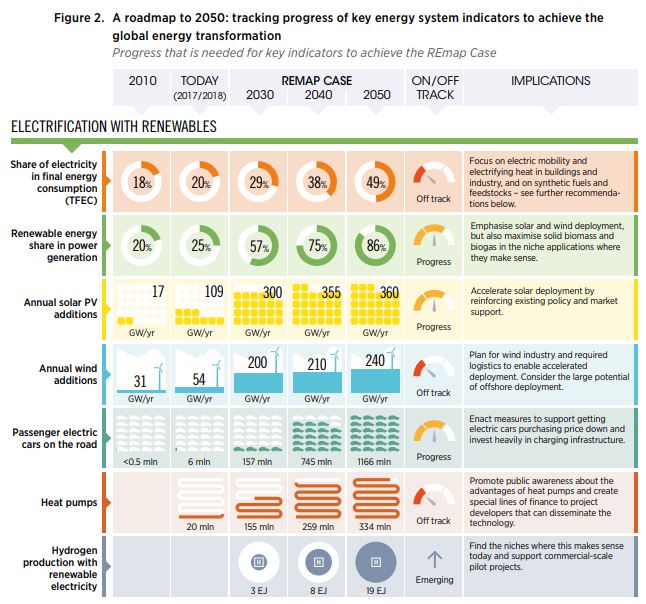
The graph makes it clear that this scenario requires a considerable scaling up of solar and wind power capacity.
What should also be noted is that the Irena scenario only delivers three quarters of the energy-related emission reductions needed to limit warming to 1.5 °C. In other words, it is not even enough to meet the Paris targets.
Here is how the Irena scenario sees the demand for fossil fuels and overall energy demand evolve:

Clearly natural gas still has a significant role to play in this scenario.
What is also noteworthy here is that the Irena pathway, like other sustainable scenarios based on renewable energy, requires a considerable acceleration of energy efficiency improvements as well as considerably lower energy consumption per head in 2050. One may wonder how realistic this is. And why, given the huge challenges involved in these renewables scenarios, organisations like Irena, LUT University and the Energy Watch Group insist on 100% renewable energy scenarios and turn a blind eye to alternatives such as carbon capture and storage and nuclear energy. In particular since, as the Irena report notes, “deployment of renewable solutions is still well below the levels needed, progress in energy efficiency is lagging and energy-related carbon dioxide emissions have increased 1.3% annually on average over the last five years.”
But that is their choice. What we can conclude is that renewable energy alone is unlikely to achieve the emission reductions required by the Paris Agreement.
Advantages of 100% renewables
None of this means that the expansion of renewable energy won’t continue or that it’s not desirable. It will and it is.
In conclusion it’s only fair to mention some advantages of a renewable energy system which are sometimes overlooked. As you may know, probably the best known 100% renewables scenario is that developed by Mark Z Jacobson of Stanford University. He published a paper in September 2017, with colleagues, showing for 139 countries around the world how they could move to a fully renewable energy system. Like LUT-EWG, Jacobson postulates a 100% conversion of the energy system to electricity, of which then 37% would be supplied by wind, 58% by solar power and the remaining 5% by geothermal, hydroelectric, tidal and wave power combined.
Jacobson’s work has been criticized, most notably by a group of scientists led by Christopher Clack from the University of Colorado, but I won’t enter into that debate here. I would just like to mention the advantages of a 100% renewable energy system which Jacobson points out. He notes that:
- A system based on WWS (i.e. wind, water, sunlight) not only replaces business-as-usual (BAU) power, but also reduces energy demand by some 42.5% because the work:energy ratio of WWS electricity exceeds that of combustion (23.0%).
- WWS requires no mining, transporting, or processing of fuels (12.6%), and WWS end-use efficiency is assumed to exceed that of BAU (6.9%).
- Converting to 100% WWS may create 24.3mn more permanent, full-time jobs than jobs lost. It may avoid 4.6mn/year premature air-pollution deaths today and 3.5mn/year in 2050; $22.8 trillion/year (12.7 ¢/kWh-BAU-all-energy) in 2050 air-pollution costs; and $28.5 trillion/year (15.8 ¢/kWh-BAU-all-energy) in 2050 climate costs.
- Transitioning should stabilise energy prices (because fuel costs are zero), reduce power disruption and increase access to energy by decentralising power, not to mention avoid 1.5C global warming.
In case you are wondering about the stability of the power grid, according to Jacobson there are “multiple solutions available to match peak demand with supply 100% of the time without bioenergy, nuclear, fossil fuels with carbon capture or natural gas” – some of them even without batteries.
Next week I will approach the same question – can we do without natural gas – from a slightly different angle. I will look at the developments in solar energy and ask: are we moving to a “solar +” energy world?
Footnote
I asked the Energy Watch Group whether it is correct that the LUT-EWG study envisages batteries supplying around 1,900 TWh of European power supply by 2050, which seemed to me an impossibly high number compared with the projections given by Bloomberg New Energy Finance (BNEF). I received the following reply by email from a spokesperson, which I am reproducing in full below:
Correct is electricity storage for the power sector of about 2,300 TWh for Europe. Total storage output is about 3,000 TWh, and this is equivalent to 17% of all electricity generation for the sectors power and heat. The total electricity generation is projected to grow up to 18,000 TWh.
BNEF [Bloomberg New Energy Finance] does not claim to go for a 1.5 °C scenario. We suggest a least cost pathway for the targets of the Paris Agreement and United Nations Sustainable Development Goals. Our scenario is more ambitious than numbers of BNEF. We cannot comment more on the BNEF scenario, since all is hidden behind a paywall and we have no access to the full scenario. Only small pieces without required data and assumptions is scattered by BNEF in the media and this is far below what is needed for a scientific check. The BNEF scenario is not accessible for science, therefore it cannot be discussed. BNEF is also not interested in discussing it with scientists. We approach them regularly, but they are not interested in exchange, including disclosure of their scenario.
About ’impossible’ (to have such amounts of storage): German utilities financed media campaigns in the pre-renewable age claiming that more than 4% renewables would be technically impossible. In 2019, 40% of all German electricity is from wind and PV and the grid is more stable than in the pre-renewable age. This ignorance and arrogance of that formerly powerful companies led to the near bankruptcy of these companies. A few weeks ago EnBW, one of the five largest German utilities, announced to build PV power plants in Germany in the next year (more than 200 MW) without any support on their own balance sheet, since the cost of PV electricity in Germany from such power plants is lower than the wholesale market price, now and expected for the relevant future while these plants are amortised.
By the way, a CEO of RWE, another almost failed German utility, said seven (!!) years ago that using PV in Germany would be as clever as growing bananas in Alaska. And now compare to EnBW boosting their profits using the same technology, without any support. Things change quite fast these days. The shareholders of RWE have lost double digit billions of euros due to the ignorance and arrogance of such failed top management.
We should listen more to the Fridays For Future school strikers, they have learnt more in school and their life than most politicians in power concerning climate change. They drew the right conclusions, understood the urgency of the disaster and shout out the right emergency tasks. It is a shame for the current generation in power, that their own kids and grand-children understand the reality and consequence of anthropogenic climate change better than those who had for decades the chance to study AND avoid it.
As long as solutions do not violate fundamental laws of nature, we should be very careful with ‘impossible’. We may be not able to imagine something, that does not mean that’s impossible.
Our energy transition pathway projection is calculated in full hourly resolution for 145 regions in the world, for realistic to conservative cost assumptions and it shows that an energy transition towards full sustainability does not cost more than the current energy system (still excluding cost of air pollution, negative impacts of subsidies, etc.). Please notice our investment cost assumptions for solar PV power plants: the assumed cost for the year 2030 is the cost level of such plants in India today (!), thus the probability is high that the cost will be even lower and the transition even faster.
The latter is demanded by the school strikers… let’s challenge more what we cannot image today, but what is possible given the right ambitions.
How will the gas industry evolve in the low-carbon world of the future? Will natural gas be a bridge or a destination? Could it become the foundation of a global hydrogen economy, in combination with CCS? How big will “green” hydrogen and biogas become? What will be the role of LNG and bio-LNG in transport?
From his home country The Netherlands, a long-time gas exporting country that has recently embarked on an unprecedented transition away from gas, independent energy journalist, analyst and moderator Karel Beckman reports on the climate and technological challenges facing the gas industry.
As former editor-in-chief and founder of two international energy websites (Energy Post and European Energy Review) and former journalist at the premier Dutch financial newspaper Financieele Dagblad, Karel has earned a great reputation as being amongst the first to focus on energy transition trends and the connections between markets, policies and technologies. For Natural Gas World he will be reporting on the Dutch and wider International gas transition on a weekly basis.
Send your comments to karel.beckman@naturalgasworld.com




